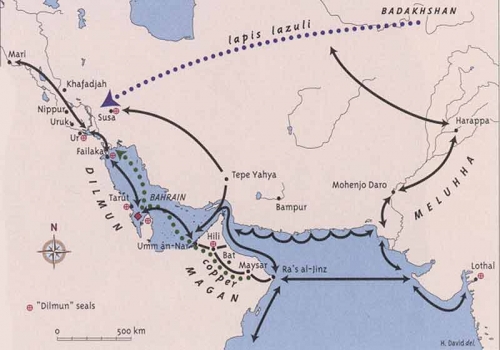New spotlight on ‘dynamic Dilmun-Harappa trade ties’
TDT | Manama
The Daily Tribune – www.newsofbahrain.com
Staff Reporter
One of the studies carried out by a leading archaeologist and epigraphist has brought fresh spotlight on the dynamic trade relations that existed between the Dilmuns and Harappans. Many research findings have already touched upon the strong trade links between the Harappan civilisation and the Dilmun civilisation and there are many archaeological sites in the Gulf region that throws light on the strong relations between the subcontinent and Arabian region.
Leading researcher in the area, Robert Carter, has always been advocating more research and studies into areas linking Indus and Dilmuns during the Bronze Age. “The apparently sudden appearance of Indus-type seals, pottery and other implements around 2000 BC in the Arabian Gulf, just before the Indus cities and culture seems to have gone into decline, is a great mystery.
“It has only deepened as recent excavations in the Gulf seem to make clear that Indus people worked their way well inland, not just in port areas. This article, while somewhat early, shows not only how important Indus seals and particularly pottery at one point in the history of this early Dilmun (Bahrain) settlement, but also that this rural town’s relationship seems to have primarily been with Gujarati Indus people given the type and style of artifacts discovered.
“Over ninety-two Dilmun-type seals have been found. Additionally, 261 fragments of sealings have been discovered. This impressive total, from a non-urban site, supports the textual evidence that the people of Early Dilmun were a trading nation, whose economy was intrinsically linked to the exchange of finished goods and raw materials from Mesopotamia, Southeast Arabia, the Harappan orbit and elsewhere.
“The scope of trade from what seems like once was such a small area reminds us that ancient peoples were not less entrepreneurial than people in more recent centuries despite what must have been much greater difficulties in travel and communication,” he says.
“Taken as a whole, Saar’s Indus-related assemblage is a highly specialised one, almost entirely consisting of large storage jars. Other characteristic Late Sorath Harappan types are absent, such as painted bowls, stud-handled bowls and dishes-on-stand. It is presently not known whether the jars are items of trade in their own right, or were purchased for their contents. The former is a possibility, given the lack of a native tradition of large necked storage jars within the Saar Period 1–3 assemblage.
“The cessation of trade between Bahrain and Gujarat is certainly connected to the end of the Early Dilmun civilisation and the final disappearance of the Harappan culture. It is not possible, however, to make simple causative links. In the first place, there is insufficient certainty as to the absolute dating of the Early Dilmun and Harappan sequences and their chronological correspondences to establish the exact sequence of developments.
“Secondly, the Bahrain-Gujarat connection is just one part of a complex web of economic, cultural and political relationships within an immense network of neighbouring regions and peoples, stretching from Central Asia to Mesopotamia, and encompassing Southeast Arabia, Eastern Arabia and highland and lowland Iran.”
The study found that various goods were traded between Bahrain and Saurashtra, other than pottery, during the early second millennium. Items recorded in the texts, transhipped to Ur via Dilmun during the Isin Larsa period, include leather goods, sheepskin containers, wooden artifacts, garments, asphalt, ivory, semi-precious stones, gold and copper. “Much of this material may have originated from the Late Harappan sphere in Saurashtra,” he observes.
Related Posts

